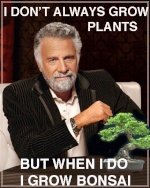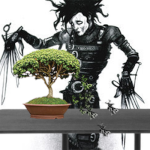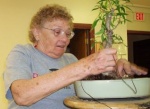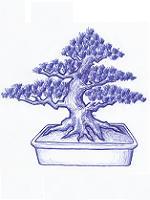Tree sexual maturity ages
+5
Bonsai Kas
coh
bonsaisr
Poink88
drgonzo
9 posters
Page 1 of 1
 Tree sexual maturity ages
Tree sexual maturity ages
Hello all,
I have a Korean Hornbeam (C. coreana) that is just swelling its male flower buds now and it's gotten me wondering what the various ages are for common Bonsai subjects to reach sexual maturity and thus ...flower.
Beech, Maple, Larch, Hornbeams, cherries, apples? I'm really curious and have had a hard time pinning down specific answers after searching quite a bit online.
Thought this might be a fun topic to get in to as flowering is perhaps one of the best parts of bonsai cultivation.
Best
-Jay
I have a Korean Hornbeam (C. coreana) that is just swelling its male flower buds now and it's gotten me wondering what the various ages are for common Bonsai subjects to reach sexual maturity and thus ...flower.
Beech, Maple, Larch, Hornbeams, cherries, apples? I'm really curious and have had a hard time pinning down specific answers after searching quite a bit online.
Thought this might be a fun topic to get in to as flowering is perhaps one of the best parts of bonsai cultivation.
Best
-Jay

drgonzo- Member
 Re: Tree sexual maturity ages
Re: Tree sexual maturity ages
Good thread.
If I may add, I also want to know if the age of a branch used either as a cutting or air layer count to the "age" of the tree towards flowering.
If I may add, I also want to know if the age of a branch used either as a cutting or air layer count to the "age" of the tree towards flowering.

Poink88- Member
 Re: Tree sexual maturity ages
Re: Tree sexual maturity ages
Good thread indeed, been searching for this information myself for quite some time. Read something about apples getting fruit at age six-eight, but don’t know for sure.. looking forward to the answer! 
Guest- Guest
 Tree Puberty Ages
Tree Puberty Ages
It varies widely. They say shagbark hickory doesn't produce nuts until the age of 25.
For most of our flowering Rosaceae, such as Prunus & crabapples, it is 10 to 15 years. I used to have an English hawthorn bonsai. When I got it, the tree was mature & bloomed from the start. But it produced a new branch lower down on the trunk. That younger branch never bloomed. I suppose it would have eventually if the tree had lived.
The question usually arises with temperate trees. Tropicals, such as Serissa, lavender star flower, and pomegranate bloom as soon as they are well rooted. They may be influenced by other factors, such as daylength.
Iris
For most of our flowering Rosaceae, such as Prunus & crabapples, it is 10 to 15 years. I used to have an English hawthorn bonsai. When I got it, the tree was mature & bloomed from the start. But it produced a new branch lower down on the trunk. That younger branch never bloomed. I suppose it would have eventually if the tree had lived.
The question usually arises with temperate trees. Tropicals, such as Serissa, lavender star flower, and pomegranate bloom as soon as they are well rooted. They may be influenced by other factors, such as daylength.
Iris

bonsaisr- Member
 Re: Tree sexual maturity ages
Re: Tree sexual maturity ages
Just found European Beech flowers at 30-80 years old one might assume other Beech would be in that range. And last night I ran into info indicating A. Palmatum blooms at 10-20 years old. I know who to bug to find out about Tridents.
I'll update as I go.
-jay
I'll update as I go.
-jay

drgonzo- Member
 Re: Tree sexual maturity ages
Re: Tree sexual maturity ages
Good to know that I have a few years before I have to have "the talk" with my Japanese maples!

coh- Member
 Re: Tree sexual maturity ages
Re: Tree sexual maturity ages
Well...I don't have long-term experience with this, but 3 crabapple air-layers that I separated over the past couple of years are in bud...we're talking about less than 1/2 inch "trunks". And just about every crabapple cutting that I've received from Brent Walston has bloomed the first season (and every season thereafter). I don't know how well this translates to other species...Poink88 wrote:Good thread.
If I may add, I also want to know if the age of a branch used either as a cutting or air layer count to the "age" of the tree towards flowering.

coh- Member
 Re: Tree sexual maturity ages
Re: Tree sexual maturity ages
Chris
I know with apples and possibly with other species as well, that clones taken from mature stock will themselves be sexually mature and ready to flower the next season.
Matt Ouwinga got back to me and said he's never personally seen a Trident flower so he's not sure what age they bloom. I do believe I have seen samaras hanging on some of Bills Tridents.
-Jay
I know with apples and possibly with other species as well, that clones taken from mature stock will themselves be sexually mature and ready to flower the next season.
Matt Ouwinga got back to me and said he's never personally seen a Trident flower so he's not sure what age they bloom. I do believe I have seen samaras hanging on some of Bills Tridents.
-Jay

drgonzo- Member
 Plum
Plum
We had one beautiful purple plum in the garden who did nothing for 15 years, then it suddenly started flowering like crazy. Gave enormous amounts of fruit for 15 more years and then suddenly died of pure exhaustion. The last years of it's life it would literally only have fruit on it near the end of the summer. Some fruit trees take a while to get going.

Bonsai Kas- Member
 Re: Tree sexual maturity ages
Re: Tree sexual maturity ages
Hi, great thread
From observation Japanese larch - 23-25 years - makes cones. Repot, major restyle etc and no flowers/cones for 2 or 3 years
grafted white pines - flowers on all trees of all sizes so assume scions are from old trees
white pine on its own roots - 40-50 year old tree (i've had it 20yrs) has had one single flower about 3 years ago !
black pine - not seen a flower on a bonsai yet - another 'own root' tree so maybe not old enough - mine about 60-70 yrs, been in uk 12 yrs, never flowered
acers - mikawa yatsubusa flowers every year and sets bright red seed pods - tree about 30 now, kiyohime not had flowers, tree well over 60.
Grafts and cuttings are sexually mature, thats one reason why they graft - jean (or Jenny) in our club has a 100 year+ juniper - a cutting i grew from the Anne Swinton tree and put in the raffle - in a way !
regards marcus
From observation Japanese larch - 23-25 years - makes cones. Repot, major restyle etc and no flowers/cones for 2 or 3 years
grafted white pines - flowers on all trees of all sizes so assume scions are from old trees
white pine on its own roots - 40-50 year old tree (i've had it 20yrs) has had one single flower about 3 years ago !
black pine - not seen a flower on a bonsai yet - another 'own root' tree so maybe not old enough - mine about 60-70 yrs, been in uk 12 yrs, never flowered
acers - mikawa yatsubusa flowers every year and sets bright red seed pods - tree about 30 now, kiyohime not had flowers, tree well over 60.
Grafts and cuttings are sexually mature, thats one reason why they graft - jean (or Jenny) in our club has a 100 year+ juniper - a cutting i grew from the Anne Swinton tree and put in the raffle - in a way !
regards marcus

marcus watts- Member
 Re: Tree sexual maturity ages
Re: Tree sexual maturity ages
Age of first flowering and fruiting is dependent on several factors. Generally each species has a 'normal' age of maturity, as Iris said for most Rosaceae trees (apples, pears, cherries, plums) somewhere around the 10 year mark.
American white pine. P strobus, I have seen forestry related articles that say 80 years is normal to the beginning of cone production.
Second, there is an individual genetics factor. Some specific clones of a species may have genetic factors that make that particular plant precocious in it bloom habit. These traits are heritable, so even whole lines of seedlings or hybrids can have early and easy bloom induction traits. I have observed an individual P. strobus landscape tree that I knew was only 40 years old produce pine cones, so either the books were wrong about the 'normal' age or this tree was a precocious tree. There are individuals that may have genes or mutations discouraging flowering. There are the sterile cones of many trees used as street trees in landscapes where litter is not desirable. The reason the A. palmatum 'Kiyp Hime' might be a 'sterile' or a reluctant blooming clone.
Third, culture plays a role that can completely trump genetics. If a plant is not growing vigorously, it may not be healthy enough to flower. Also for some species there is a minimum physical size that is required to produce fruit. This can be because of the energy required or like grapes blooming primarily on wood begining its second season, it may be related to the habit of the species.
Separately the plant may be healthy enough to flower but the bonsai pruning techniques are preventing the flowering. I suspect that the repeated de-candling of Japanese Black Pines may be a factor in the lack of production of pine cones for that species. White pines are pruned differently and there are more frequent reports of these trees producing cones. So even though the tree may be mature enough to produce flowers and fruit, we may be doing something with bonsai culture techniques that prevents the production of seed. My 100 year old ponderosa always produces male cones, but never seems to produce female cones. I usually do fall bud pruning, and I suspect that I am pruning out the buds most likely to produce female cones.
Graft and cutting produced plants will be 'genetically' as old as the original source material. They just need to get the culture that encourages blooming and they will bloom.
Those are my thoughts. It is not an exhaustive list, but these came to mind when I read this post.
American white pine. P strobus, I have seen forestry related articles that say 80 years is normal to the beginning of cone production.
Second, there is an individual genetics factor. Some specific clones of a species may have genetic factors that make that particular plant precocious in it bloom habit. These traits are heritable, so even whole lines of seedlings or hybrids can have early and easy bloom induction traits. I have observed an individual P. strobus landscape tree that I knew was only 40 years old produce pine cones, so either the books were wrong about the 'normal' age or this tree was a precocious tree. There are individuals that may have genes or mutations discouraging flowering. There are the sterile cones of many trees used as street trees in landscapes where litter is not desirable. The reason the A. palmatum 'Kiyp Hime' might be a 'sterile' or a reluctant blooming clone.
Third, culture plays a role that can completely trump genetics. If a plant is not growing vigorously, it may not be healthy enough to flower. Also for some species there is a minimum physical size that is required to produce fruit. This can be because of the energy required or like grapes blooming primarily on wood begining its second season, it may be related to the habit of the species.
Separately the plant may be healthy enough to flower but the bonsai pruning techniques are preventing the flowering. I suspect that the repeated de-candling of Japanese Black Pines may be a factor in the lack of production of pine cones for that species. White pines are pruned differently and there are more frequent reports of these trees producing cones. So even though the tree may be mature enough to produce flowers and fruit, we may be doing something with bonsai culture techniques that prevents the production of seed. My 100 year old ponderosa always produces male cones, but never seems to produce female cones. I usually do fall bud pruning, and I suspect that I am pruning out the buds most likely to produce female cones.
Graft and cutting produced plants will be 'genetically' as old as the original source material. They just need to get the culture that encourages blooming and they will bloom.
Those are my thoughts. It is not an exhaustive list, but these came to mind when I read this post.

Leo Schordje- Member
 Re: Tree sexual maturity ages
Re: Tree sexual maturity ages
I forgot to mention that some plants actually flowers when stressed as last (and valiant) effort to reproduce before it dies.

Poink88- Member
 bonsai: the land of eternal youth
bonsai: the land of eternal youth
So even though the tree may be mature enough to produce flowers and fruit, we may be doing something with bonsai culture techniques that prevents the production of seed.
 my suspicion would be that Leo has the right of this...
my suspicion would be that Leo has the right of this... someone some of us once knew mentioned that if you wanted your kids to be young forever.. get a bonsai...
that way even though its 35 years old the foliage will be no more than 5 years old. And its easier to move it back into the basement and they all abide by the house rules during sleep overs...
Indeed, the land of eternal youth. And a bit of an oxymoron: why value the age of a tree when the foliage is always juvenile?
a further question of maturity of bonsai that comes to mind is, is it possible to successfully reduce foliage size, and 'engage' in the bonsai process (reducing growth etal) and have mature seed production growth on a bonsai? Is this possible? Fruiting varieties would be likely, whereas on pine, would pine bonsai be possible without the momiage needle stripping in the fall? (or, phrased the other way, have you seen your pine bonsai flower yet?) curious... thanks edzard

fuzei- Member
 Re: Tree sexual maturity ages
Re: Tree sexual maturity ages
I have a young (4 yr old?) grafted Arakawa Japanese maple that produced a handful of seeds but they were very small and immature. I am sure they were not fertile seed cause the seed body was almost paper thin with zero endosperm.
FrankP999- Member
 Re: Tree sexual maturity ages
Re: Tree sexual maturity ages
fuzei wrote: (or, phrased the other way, have you seen your pine bonsai flower yet?)
hi, yes the 2 grafted white pine bonsai I have flower regularly - the stress of wiring, pruning, repotting etc make them flower more heavily the following year, which is always annoying as it makes building ramification and density in those years a much slower process


cheers Marcus

marcus watts- Member
 sex of strobili, micro or mega ... ?
sex of strobili, micro or mega ... ?
Frankp999.. yes, I think that 4 years old for a Japanese maple is a bit young to be producing viable seed, and most people I've spoken with have little luck in propagating Japanese maple seeds. At least its trying...
Marcus,
The location of the pine flower, the female megastrobili is a bit unusual for me as I grow predominantly Scot's, Lodgepole and Jack pine. I wonder about the timing of the photograph, as I would expect that this spring's 'current' photograph of the female pine flower, the bracts would still be open, and be located at the ends of the terminal in 2 or 3 structures. To have that many potential seed bearing cones on each terminal is proving that white pine must be almost a weed tree by now.
Here is what i am used to seeing as a pine flower: about 4/5th's down
http://www.microscopy-uk.org.uk/mag/artapr09/bj-scotspine.html
Perhaps you are thinking of the flower as the male pollen microstrobili? Would you have a photo of the male pollen strobili ? Or, perhaps I am mistaken as to which part of the plant the ovules are in... and commonly referred to as the 'flower'.
perhaps I am mistaken as to which part of the plant the ovules are in... and commonly referred to as the 'flower'.
.... pssst Marcus..
Marcus..  stop pruning for long stemmed roses.. think 'bud vase'.. 'bud' vase = no stem needed'
stop pruning for long stemmed roses.. think 'bud vase'.. 'bud' vase = no stem needed'
-- why not remove the cones as soon as they emerge and use the energy for latent buds? Really tight cuts.
{why are you practising momiage on the stem sides? would you not beget denser foliage if you cut the needles so that the sheath is not damaged?? Then cut back to the newly developed buds? ... wrong topic area... some other time I'd be curious}
edzard
Marcus,
quite impressive: you would have about 26 seed cones in one location? that,... is quite productive.hi, yes the 2 grafted white pine bonsai I have flower regularly - the stress of wiring, pruning, repotting etc make them flower more heavily the following year
The location of the pine flower, the female megastrobili is a bit unusual for me as I grow predominantly Scot's, Lodgepole and Jack pine. I wonder about the timing of the photograph, as I would expect that this spring's 'current' photograph of the female pine flower, the bracts would still be open, and be located at the ends of the terminal in 2 or 3 structures. To have that many potential seed bearing cones on each terminal is proving that white pine must be almost a weed tree by now.
Here is what i am used to seeing as a pine flower: about 4/5th's down
http://www.microscopy-uk.org.uk/mag/artapr09/bj-scotspine.html
Perhaps you are thinking of the flower as the male pollen microstrobili? Would you have a photo of the male pollen strobili ? Or,
.. are you sure it is not an opportunity? or the plant should rest?which is always annoying as it makes building ramification and density in those years a much slower process
.... pssst
-- why not remove the cones as soon as they emerge and use the energy for latent buds? Really tight cuts.
{why are you practising momiage on the stem sides? would you not beget denser foliage if you cut the needles so that the sheath is not damaged?? Then cut back to the newly developed buds? ... wrong topic area... some other time I'd be curious}
edzard

fuzei- Member
 Similar topics
Similar topics» Trunk maturity (Question)
» SUMO OLIVE
» Tamarind - how the trunk ages
» A few ages of the Japanese black pine
» need to id my new tree
» SUMO OLIVE
» Tamarind - how the trunk ages
» A few ages of the Japanese black pine
» need to id my new tree
Page 1 of 1
Permissions in this forum:
You cannot reply to topics in this forum






